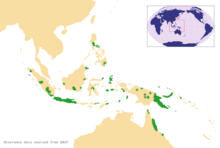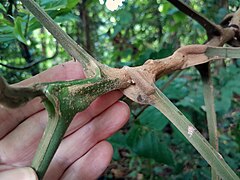| Yellow mahogany | |
|---|---|

| |
| Flowering at Mount Hypipamee National Park, November 2022 | |
| Conservation status | |
| Least Concern (NCA) | |
| Scientific classification | |
| Kingdom: | Plantae |
| Clade: | Tracheophytes |
| Clade: | Angiosperms |
| Clade: | Eudicots |
| Clade: | Rosids |
| Order: | Sapindales |
| Family: | Meliaceae |
| Genus: | Epicharis |
| Species: | E. parasitica |
| Binomial name | |
| Epicharis parasitica (Osbeck) Mabb. | |

| |
| Synonyms | |
46 synonyms
| |
Epicharis parasitica, commonly known as yellow mahogany, is a species of tree in the family Meliaceae; it grows primarily in tropical rainforests and is native to Taiwan, parts of Malesia, Papuasia, and northeast Queensland.
Description
Epicharis parasitica grows up to 36 m (118 ft) tall with a trunk diameter of up to 60 cm (24 in). Buttresses may be present, growing up to 1.5 m (4 ft 11 in) tall and wide. The bark is yellowish to grey-brown, and smooth to flaky with scattered lenticels.
The compound leaves are arranged spirally on the twigs and measure up to 1.5 m (4 ft 11 in) long with up to 19 leaflets. Leaflets are oblong to ovate in shape and up to 19 cm (7.5 in) long by 6 cm (2.4 in) wide, with about 14 lateral veins each side of the midrib.
The inflorescence is a raceme up to 30 cm (12 in) long, growing from protrusions on the trunk of the tree in a process called cauliflory, or from woody branches (ramiflory). The sweetly scented flowers are white or cream with four petals. The white staminal tube measures about 15 mm (0.59 in) long and 4 mm (0.16 in) wide.
The fruit is a globose red-brown capsule about 4 to 5 cm (1.6 to 2.0 in) diameter. It has up to four segments with one seed contained in each. The seeds are about 2 cm (0.79 in) long, brownish-black and with an orange-red sarcotesta.
Taxonomy
This species was first described by the Swedish naturalist Pehr Osbeck as Melia parasitica, and published in 1757 in his book Dagbok ofwer en Ostindisk Resa aren 1750, 1751, 1752. Since then, it had been described more than 40 times by various authors who gave it various names (see synonyms), before it was transferred to the genus Dysoxylum by Indonesian botanist André Joseph Guillaume Henri Kostermans in 1966. Australian populations were known as Dysoxylum schiffneri.
Etymology
The genus name comes from the Latin dys meaning 'bad', and the Ancient Greek xylon meaning 'wood', and refers to the unpleasant smell produced by some species. The species epithet is from the Latin word parasiticus meaning 'parasitic', referring to Osbeck's early mistaken belief that the flowers were parasitic.
Distribution and habitat
The yellow mahogany's natural range includes Taiwan, the Philippines, Borneo, Sumatra, Java, Sulawesi, Maluku, East Timor, New Guinea, the Bismarck Archipelago, the Solomon Islands and Queensland. It grows in well developed rainforest, including that on limestone, at altitudes from sea-level to around 2,100 m (6,900 ft).
Ecology
The flowers are visited by butterflies, an important pollinator of the family. Possums and bats also contribute to the pollination as they climb the trunk of the tree looking for food.
Uses
Epicharis parasitica has potential as a feature tree in parks or gardens in areas with subtropical or tropical climates.
Cultivation
It prefers acid soils with good drainage and dappled sun or part-shade. The species can be propagated by fresh seed.
Gallery
-
 Fruit
Fruit
-
 Inflorescence on the trunk
Inflorescence on the trunk
-
 On a branch
On a branch
-
 Young tree
Young tree
-
 Foliage
Foliage
-
 Flower buds
Flower buds
-
 Leaves
Leaves
-
 Stout petioles attached to the twig
Stout petioles attached to the twig
References
- "Species profile—Dysoxylum parasiticum". Queensland Department of Environment and Science. Queensland Government. 2022. Retrieved 25 September 2023.
- ^ "Epicharis parasitica". Australian Plant Name Index (APNI). Centre for Australian National Biodiversity Research, Australian Government. Retrieved 16 February 2024.
- ^ "Epicharis parasitica (Osbeck) Mabb". Plants of the World Online. Royal Botanic Gardens, Kew. 2024. Retrieved 28 October 2024.
- ^ Mabberley, D.J. (2022). Kodela, P.G. (ed.). "Dysoxylum parasiticum". Flora of Australia. Australian Biological Resources Study, Department of Climate Change, the Environment and Water: Canberra. Retrieved 25 September 2023.
- ^ Mabberley, David J.; Pannel, C. M.; Sing, A. M. (1995). Flora Malesiana. Series I, Spermatophyta : Flowering Plants. Vol. 12 pt. 1: Meliaceae. Leiden: Rijksherbarium / Hortus Botanicus, Leiden University. pp. 76–81. ISBN 90-71236-26-9. Retrieved 15 Mar 2014.
- ^ "Dysoxylum parasiticum (Osbeck) Kostermans, Reinwardtia. 7: 247. 1966". Flora of China (eFloras). Missouri Botanical Garden, St. Louis, MO & Harvard University Herbaria, Cambridge, MA. Retrieved 23 September 2023.
- ^ Cooper, Wendy; Cooper, William T. (June 2004). "Dysoxylum parasiticum (Osbeck) Kosterm.". Fruits of the Australian Tropical Rainforest. Clifton Hill, Victoria, Australia: Nokomis Editions. p. 290. ISBN 9780958174213.
- Osbeck, Pehr (1757). Dagbok öfwer en Ostindisk resa åren 1750, 1751, 1752. Stockholm: Tryckt hos Lor. Ludv. Grefing. p. 278. Retrieved 25 September 2023.
- F.A. Zich; B.P.M Hyland; T. Whiffen; R.A. Kerrigan (2020). "Dysoxylum parasiticum". Australian Tropical Rainforest Plants, Edition 8. Commonwealth Scientific and Industrial Research Organisation (CSIRO). Retrieved 21 March 2021.
- ^ Elliot, Rodger W.; Jones, David L.; Blake, Trevor (1984). Encyclopaedia of Australian Plants Suitable for Cultivation: Volume 3 - Ce-Er. Port Melbourne, Victoria: Lothian Press. p. 377. ISBN 0-85091-167-2.
- "Dysoxylum parasiticum (Osbeck) Kosterm". Global Biodiversity Information Facility. Retrieved 25 September 2023.
- Mabberley, David J.; Sing, Anne M. (March 2007). Soepadmo, E.; Saw, L. G.; Chung, R. C. K.; Kiew, Ruth (eds.). Tree Flora of Sabah and Sarawak (PDF). Vol. 6. Forest Research Institute Malaysia. pp. 173–174. ISBN 978-983-2181-89-7. Archived from the original on 27 September 2013. Retrieved 9 March 2014.
- "Daintree Rainforest Plants". Daintree Rainforest Discovery Centre. Retrieved 26 September 2023.
External links
- [REDACTED] Data related to Epicharis parasitica at Wikispecies
- [REDACTED] Media related to Epicharis parasitica at Wikimedia Commons
- View a map of recorded sightings of this species at the Australasian Virtual Herbarium
- View observations of this species on iNaturalist
- See images of this species on Flickriver
| Taxon identifiers | |
|---|---|
| Epicharis parasitica | |
| Melia parasitica | |